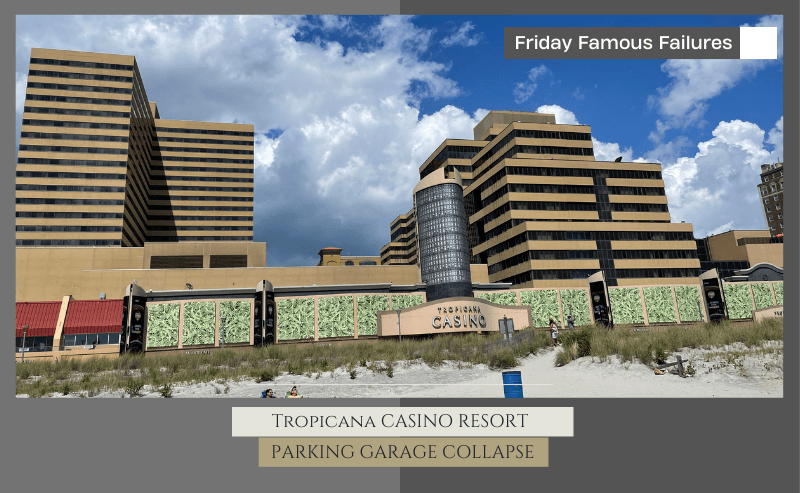Introduction
On October 30, 2003, a parking garage under construction at the Tropicana Casino Resort in Atlantic City, New Jersey, collapsed, resulting in the deaths of four construction workers and injuries to 21 others.
The Occupational Safety and Health Administration (OSHA) conducted an investigation into the incident and found that the primary cause of the collapse was the lack of adequate shoring and bracing to support the weight of the precast concrete slabs. Additionally, the investigation found numerous construction deficiencies, including poor quality control, inadequate communication between the design team, construction team, and building inspectors, and a lack of proper safety training for the construction workers.
The investigation also identified the lift-slab construction method used to build the parking garage as a contributing factor to the collapse, as this method is known to be more susceptible to structural failure than other construction methods.
Background and the Collapse
The Tropicana Casino Resort was one of Atlantic City’s premier gambling destinations, drawing thousands of visitors each year. As part of a major renovation effort, the Tropicana embarked on an ambitious construction project to build a nine-story parking garage. The project began in 2002 and was expected to take approximately 14 months to complete.
The parking garage was being built using the lift-slab construction method, a process in which concrete slabs are poured on the ground, lifted into place using hydraulic jacks, and then supported by temporary columns until they are permanently secured. This method was chosen for its speed and efficiency, as it allowed for faster construction times and reduced costs. However, the use of this method also requires careful planning, design, and execution to ensure structural integrity and safety.
During the early morning hours of October 30, 2003, workers were pouring concrete on the sixth floor of the garage. Suddenly, without warning, the entire structure collapsed, sending workers and debris crashing down to the ground. The collapse was so severe that it was felt throughout the surrounding area, and many feared a terrorist attack or earthquake had occurred.
Emergency responders rushed to the scene, and a massive search and rescue effort began. Sadly, four workers were killed in the collapse, and 21 others were injured, some critically. The incident was a tragic reminder of the dangers of construction work and the importance of ensuring proper safety protocols are in place and followed.
OSHA immediately launched an investigation into the incident to determine the cause of the collapse and identify any potential violations of safety regulations. The investigation lasted several months and involved a thorough review of construction documents, witness statements, and physical evidence.
The investigation ultimately found that the primary cause of the collapse was the lack of adequate shoring and bracing to support the weight of the precast concrete slabs. The investigation also identified numerous construction deficiencies, including poor quality control, inadequate communication between the design team, construction team, and building inspectors, and a lack of proper safety training for the construction workers.
Additionally, the investigation found that the lift-slab construction method used to build the parking garage was a contributing factor to the collapse, as this method is known to be more susceptible to structural failure than other construction methods.
Lessons Learned
Design Flaws
One of the primary factors identified by the OSHA investigation was design flaws. The design of the parking garage did not consider the weight of the precast concrete slabs or the load capacity of the support columns. This led to a structure that was not strong enough to support the weight of the building. Engineers must prioritize a thorough analysis of the design before construction begins to ensure that it is structurally sound and can withstand any possible loads and stresses that the structure may encounter during its lifetime.
Quality Control
The OSHA investigation found numerous construction deficiencies, including inadequate shoring and bracing, improper welding, and poor quality control. Quality control is a critical aspect of construction to ensure that all components of the structure are built to the required specifications. Engineers must prioritize regular inspections of the work site, testing of materials, and adherence to industry standards to ensure that construction meets the required specifications and is of high quality.
Effective Communication
Effective communication is critical during all phases of construction to ensure that all parties are aware of any changes or issues that may arise. The OSHA report identified a breakdown in communication between the design team, the construction team, and the building inspectors. This resulted in critical information not being conveyed to the construction team, leading to construction deficiencies. Engineers must prioritize effective communication between all parties involved in the construction process to ensure that critical information is conveyed and acted upon promptly.
Evaluation of Construction Methods
The OSHA investigation found that the lift-slab construction method used to build the parking garage was a contributing factor to the collapse. This method is known to be more susceptible to structural failure than other construction methods. Although innovative construction methods may offer cost and time savings, engineers must carefully evaluate their suitability for the specific project. Factors such as structural integrity, safety, and quality must be considered when selecting a construction method.
Safety Training
The OSHA investigation found that the construction workers on the site were not adequately trained in safety procedures. Safety training is essential to ensure that workers are aware of the potential hazards on the job site and know how to protect themselves and their colleagues.
Conclusion
The Tropicana Casino Resort parking garage collapse provides a valuable lesson for engineerson the importance of proper design, construction, and communication in building structures. This tragic event highlights the need for thorough analysis during the design phase, quality control during construction, effective communication between all parties involved, and careful evaluation of construction methods.
Engineers must prioritize safety and structural integrity above all else to ensure that tragedies like the Tropicana Casino Resort parking garage collapse do not happen again. By learning from this incident, engineers can work towards creating safer and more structurally sound buildings in the future.









Based on the collapse of the L’Ambiance Plaza, designers and contractors should have been extra vigilant when utilizing lift slab construction..
“The design of the parking garage did not consider the weight of the precast concrete slabs…” ?? They forgot to include the DL of the concrete slabs in the design of the columns? Lordy. Sounds unlikely so I would need more context to be judgmental.